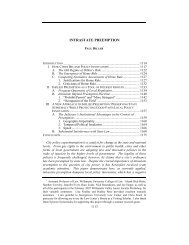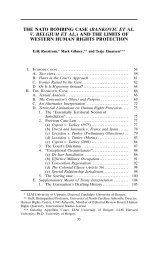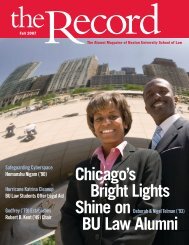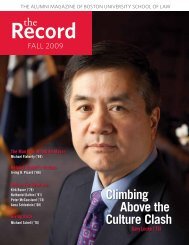the nature of representation: the cherokee right ... - Boston University
the nature of representation: the cherokee right ... - Boston University
the nature of representation: the cherokee right ... - Boston University
You also want an ePaper? Increase the reach of your titles
YUMPU automatically turns print PDFs into web optimized ePapers that Google loves.
2005] THE NATURE OF REPRESENTATION 117<br />
Treaty was framed in terms <strong>of</strong> his leadership responsibilities: “We cannot . . .<br />
disrobe ourselves <strong>of</strong> our delegated authority, and act as individuals, by uniting<br />
ourselves with <strong>the</strong> unauthorized few who have entered into a contract with <strong>the</strong><br />
United States, in <strong>the</strong> form <strong>of</strong> a treaty.” 138 The U.S. government oscillated between<br />
recognition and non-recognition <strong>of</strong> Ross’s leadership, for while <strong>the</strong> Treaty was<br />
negotiated without Ross, <strong>the</strong> Senate did accept memorials <strong>of</strong> protest from <strong>the</strong> Ross<br />
group despite protests from Georgia that Ross was not a leader whom <strong>the</strong> Senate<br />
should implicitly recognize through memorial acceptance. 139<br />
Schermerhorn<br />
believed, “<strong>the</strong> principal, if not only ground, <strong>of</strong> objection to <strong>the</strong> treaty, is, because it<br />
was made by unauthorized individuals, and not by <strong>the</strong> self-constituted authorities <strong>of</strong><br />
<strong>the</strong> nation.” 140 That even <strong>the</strong> U.S. negotiator expressed concern about <strong>the</strong> authority<br />
<strong>of</strong> <strong>the</strong> individuals signing <strong>the</strong> Treaty supports some <strong>of</strong> <strong>the</strong> Cherokee beliefs<br />
regarding <strong>the</strong> illegitimacy <strong>of</strong> <strong>the</strong> Treaty at <strong>the</strong> time it was signed. 141<br />
B. Understanding <strong>the</strong> New Echota Treaty Disputes<br />
The disputes—among Cherokees, among U.S. agents, and between <strong>the</strong> U.S.<br />
government and <strong>the</strong> Cherokees—that make up <strong>the</strong> historical background <strong>of</strong> <strong>the</strong> New<br />
Echota Treaty do not ultimately undermine present claims based upon that Treaty.<br />
The history is important and must be understood because it can be used to<br />
question <strong>the</strong> delegate provisions. But disputes should not be divorced from <strong>the</strong> fact<br />
that <strong>the</strong> U.S. government wrote <strong>the</strong> Treaty, including <strong>the</strong> delegate provision,<br />
treated it as a valid treaty, and used it as <strong>the</strong> legal mechanism to force Cherokee<br />
removal. 142 The history <strong>of</strong> <strong>the</strong> Treaty negotiations, including <strong>the</strong> disputes and<br />
138<br />
Letter from Cherokee Delegate headed by John Ross to Lewis Cass (Feb. 29,<br />
1836), in 1THE PAPERS OF CHIEF JOHN ROSS, supra note 14, at 389.<br />
139<br />
THE FEDERAL UNION, June 4, 1834, at 3.<br />
140<br />
Letter fromJohn F. Schermerhorn, to Lewis Cass (Mar. 3, 1836), in TREATY WITH<br />
THE CHEROKEE INDIANS, 24th Cong., 1st Sess., 54-61, at 59. A similarpoint was made by<br />
Wilson Lumpkin who attacked Ross’s insistence that negotiation occur only with<br />
representatives <strong>of</strong> <strong>the</strong> Cherokee government: “Ross opposed [<strong>the</strong> New Echota Treaty]<br />
because it was negotiated by his rivals and because it did not recognize him as anything<br />
more than a common Indian.” 2 LUMPKIN, supra note 3, at 32.<br />
141<br />
For general description <strong>of</strong> <strong>the</strong> disputes involved in <strong>the</strong> New Echota Treaty<br />
negotiations, see Letter from John Ridge and S. Watie to John F. Schermerhorn, U.S.<br />
Commissioner (Feb. 26, 1836), in TREATY WITH THE CHEROKEE INDIANS, 24th Cong., 1st<br />
Sess., 46-49 at 46.; Petitions <strong>of</strong> Protest signed by 3,250 persons, S. Exec. Doc. No. 23-7,<br />
23d Cong., 1st Sess., at 53; Letter from John F. Schermerhorn, to Lewis Cass (Mar. 3,<br />
1836), in TREATY WITH THE CHEROKEE INDIANS, 24th Cong., 1st Sess., 54-61; Treaty <strong>of</strong><br />
New Echota, supra note 1, Preamble. See generally, Notice from J.F. Schermerhorn and<br />
Gov. William Carroll, U.S. Commissioners, To <strong>the</strong> Chiefs, Head Men, and People <strong>of</strong> <strong>the</strong><br />
Cherokee Nation <strong>of</strong> Indians (Nov. 3, 1835), in TREATY WITH THE CHEROKEE INDIANS,24th<br />
Cong., 1st Sess., 19 (discussing authority <strong>of</strong> Cherokee nation).<br />
142<br />
The validity <strong>of</strong> <strong>the</strong> Treatycomesacross through <strong>the</strong> number<strong>of</strong> citations <strong>the</strong> Treaty<br />
receives on a wide range <strong>of</strong> issues frequently related to water and land <strong>right</strong>s. For









